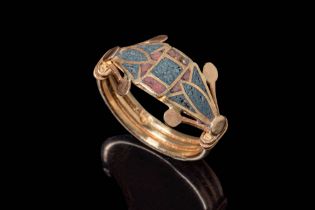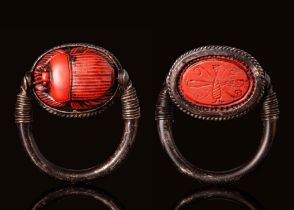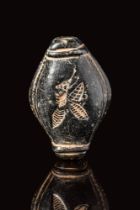Refine your search
Sale Section
- Amlash (3)
- Anatolian (1)
- Anglo-Saxon (1)
- Assyrian (1)
- Babylonian (4)
- Bactrian (2)
- Bohemian (1)
- Bronze Age (7)
- Byzantine (21)
- Canosan (2)
- Carthaginian (1)
- Celtic (5)
- Cuneiform tablet (6)
- Cylinder seals (14)
- Cypriot (7)
- Egyptian (44)
- Elamite (3)
- Etruscan (20)
- Gandharan (10)
- Gothic (1)
- Graeco-Roman (1)
- Greek (98)
- Illyrian (1)
- Indus Valley (4)
- Kashan (1)
- Medieval (22)
- Merovingian (6)
- Mesopotamian (12)
- Nabatean (1)
- Near Eastern (1)
- Phoenician (4)
- Post-medieval (1)
- Roman (83)
- Romano-Egyptian (6)
- Sasanian (3)
- Scythian (2)
- Seljuk (4)
- South Arabian (3)
- Stamp seals (18)
- Syro-Hittite (1)
- Tell Brak (2)
- Umayyad (1)
- Viking (16)
- Villanovan (3)
- Weaponry (2)
- Western Asiatic (30)
- 中文 (16)
Estimate
Category
- Jewellery (124)
- Greek, Roman, Egyptian & other antiquities (65)
- Sculpture (55)
- Glassware (31)
- Arms, Armour & Militaria (29)
- Books, Manuscripts & Periodicals (28)
- Chinese Works of Art (27)
- Ceramics (19)
- Collectables (19)
- Taxidermy & Natural History (17)
- Salvage & Architectural Antiques (16)
- Clocks (10)
- Stamps (10)
- Coins (9)
- Metalware (8)
- Textiles (8)
- Porcelain (6)
- Kitchenalia (4)
- Russian Works of Art (3)
- Vintage Fashion (3)
- Islamic Works of Art (2)
- Prints & Multiples (2)
- Ethnographica & tribal art (1)
- Furniture (1)
- Lighting (1)
- Silver & Silver-plated items (1)
Creator / Brand
Item Type
- Ring (82)
- Necklaces, Pendants & Medallions (35)
- Gold Ring (34)
- Gemstone (29)
- Pendant (24)
- Silver Ring (22)
- Vessel (22)
- Intaglio (21)
- Necklace (21)
- Band (18)
- Knives and Blades (17)
- Letter (15)
- Bracelet (14)
- Chinese Art by Period / Style (13)
- Bowl (12)
- Figure (11)
- Garnet (11)
- Flask (10)
- Signet Ring (10)
- Stamp (10)
- Beads (9)
- Earrings (9)
- Gold Pendant (9)
- Jewellery Brands (8)
- Knives (8)
- Krater (8)
- Spearhead (8)
- Vase (8)
- Chain (7)
- Dagger (7)
- Militaria (7)
- Dish (6)
- Plate (6)
- Terracotta Figure (6)
- Ushabti (6)
- Axe (5)
- Brooch (5)
- Bust (5)
- Helmet (5)
- Military Helmet (5)
- Scarab (5)
- Skyphos (5)
- Amethyst (4)
- Amulet (4)
- Armour (4)
- Cup (4)
- Jug (4)
- Kantharos (4)
- Patera (4)
- Sword (4)
- Torc (4)
- Arch (3)
- Belt (3)
- Brooches (3)
- Cameo (3)
- Column (3)
- Intaglio Ring (3)
- Jar (3)
- Lamp (3)
- Medallion (3)
- Sculpture (3)
- Silver Bracelet (3)
- Spear (3)
- 19th-21st Century Art (2)
- Badges, Medals & Pins (2)
- Beaker (2)
- Blunt (2)
- Blunt Weapons (2)
- Bottle (2)
- British Coin (2)
- Carving (2)
- Ceramic Bowl (2)
- Ceramic Jug (2)
- Diamond (2)
- Earring (2)
- European Coin (2)
- Glass Beaker (2)
- Kyathos (2)
- Mace (2)
- Metal Cup (2)
- Military Belt (2)
- Military Pin (2)
- Military Uniform (2)
- Noble (2)
- Pearls (2)
- Pin (2)
- Plaque (2)
- Posy Ring (2)
- Scabbard (2)
- Sheath (2)
- Tableware (2)
- Amphora (1)
- Archery Equipment (1)
- Bangle (1)
- Bear (1)
- Bear Taxidermy (1)
- Bell (1)
- Belt buckle (1)
- Bow (1)
- Box (1)
- Buddha (1)
- Cap (1)
- Capital (1)
- Ceramic Urn (1)
- Choker (1)
- Club (1)
- Collar (1)
- Comic (1)
- Comic book (1)
- Crossbow (1)
- Crown (1)
- Ewer (1)
- Figurine (1)
- Fragment (1)
- Glass Bottle (1)
- Glass Jug (1)
- Gypsum (1)
- Hunting Knives (1)
- Knife (1)
- Ladle (1)
- Mask (1)
- Metal Vase (1)
- Military Brooch (1)
- Olpe (1)
- Pitcher (1)
- Rattle (1)
- Robe (1)
- Round (1)
- Ruby (1)
- Sabre (1)
- Sceptre (1)
- Seax (1)
- Silver Brooch (1)
- Sleeve (1)
- Statuette (1)
- Stick (1)
- Table (1)
- Taxidermy (1)
- Turquoise (1)
- Urn (1)
- Utensil (1)
- silver bowl (1)
- List
- Grid
New Kingdom, 18th Dynasty, Ca. 1353 - 1336 BC. A relief, carved from pale orange sandstone, depicting a tall figure, probably a princess of the Ne...
XXV Dynasty 747-664 BC. An Egyptian fragment of a funerary stela. This is likely the second register of the stela: the offerings for the deceased ...
Late Period, Ca. 664 - 332 BC. A head of a male figure carved from granite, with an age-darkened surface. The piece exhibits traditional elongated...
Third Intermediate Period, 22nd-25th Dynasties, Ca. 945 - 700 BC; probably from Lower Egypt.. An upper part of lid of a wooden coffin decorated wi...
End of the Old Kingdom / Beginning of the First Intermediate Period, Dynasties VII-VIII, Ca. 2181 - 2160 BC. A beautiful limestone Egyptian false ...
New Kingdom, 19th Dynasty, Ca. 1307 - 1196 BC. A black stone head of a pharaoh. The figure wears a headdress with visible detailing, though weathe...
Late Period, Ca. 664 - 332 BC. A stunning sandstone panel with two main figures. The first is a woman, possibly a goddess consort like Mut or Amen...
Middle Kingdom, Ca. 1991 - 1790 BC. A rare faience of a hand-built concubine, nude and covered in turquoise-hued glaze, with arms held loosely at ...
Middle Kingdom, Ca. 2055 - 1790 BC. A carved wooden female figure stands atop an integral platform, featuring close-set legs with slightly bent kn...
Ca. 1069 - 664 BC. A faience ushabti standing in a dignified pose, that is enrobed in layers of incredibly lustrous, brilliant pale faience glaze....
Late Period to Ptolemaic Period, Ca. 664 - 30 BC. A bronze feline head with upright ears, deep-set eyes, a defined nose with whisker pads, and a c...
18th Dynasty, Ca. 1353 - 1336 BC. A block of crystalline marble shaped as a double cartouche, enclosing inscriptions of the sun disc Aten: “Ra-Har...
HUGE EGYPTIAN ALABASTER JAR
Early Dynastic, Ca. 3100 - 2686 BC. A carved alabaster jar of sturdy form and creamy tan hue with a baluster-shaped body and a squat rim atop the ...
Late Period, Ca. 664 - 332 BC. A sandstone relief with inscription. The upper hieroglyphs on this fragment read "God's Father," indicating a pries...
New Kingdom - Late period, Ca. 1550 - 332 BC. A necklace composed of two main strands featuring tubular-shaped faience beads in a blue hue charact...
Ca. 100 BC - AD 100. A circular gold plaque with a recessed central field bordered by a flat rim, incised with fine hatching along its edge. The c...
EGYPTIAN GOLD RAISED COBRA
Late Period, Ca. 664 - 332 BC. A mould-formed gold amulet of a snake representing an asp or a royal uraeus cobra. The serpentine creature rests at...
Ptolemaic Period, Ca. 332 - 30 BC. A gold 21 ct bracelet shaped like a snake features five coils, with the head and tail crafted in realistic deta...
Ca. 30 BC - AD 200. A gold 21.8 ct snake ring with a naturalistic head and engraved scales on the body and on the head, the tail is slightly twist...
New Kingdom, Ca. 1550 - 1069 BC. A stunning gold ring with a round, column-shaped hoop and a bezel designed in the form of two lotus flower capita...
Late Period, Ca. 664 - 332 BC. A silver ring with a semicircular hoop featuring a conical section tapering to the bottom, connected to a square be...
Ca. 664 - 332 BC. A gold swivel ring set with a deep violet-purple amethyst, oval-shaped scarab. The upper body of the scarab is intricately carve...
EGYPTIAN AMETHYST SCARAB
Middle Kingdom - New Kingdom, Ca. 2055 - 1069 BC. A carved amethyst scarab of ovoid form with naturalistic features with folded wings represented ...
New Kingdom, Ca. 1550 - 1069 BC. A granite ushabti standing in mummiform with fused legs, holding farming implements for agricultural work in the ...
EGYPTIAN LIMESTONE USHABTI
New Kingdom, Ca. 1550 - 1069 BC. A carved limestone ushabti figure standing in mummiform with fused legs and feet protruding from the base. The fi...
New Kingdom, 19th Dynasty, Ca. 1292 - 1190 BC. A limestone ushabti with extraordinary original pigment preserved, featuring black-painted hierogly...
EGYPTIAN WOODEN STATUETTE
Old Kingdom, First Intermediate Period, Ca. 2400 - 2055. Carved from a single piece of wood, this male figure strides forward with the left leg ad...
End of XXXth Dynasty/Beginning of the Ptolemaic Period (Ca. 379 - 280 BC). A faience ushabti with a tall, mummiform stance atop an integral rectan...
Late Period, ca. 664 - 525 BC. A cast leaded-bronze figure of pharaoh, who holds a crook and flail in arms placed neatly atop the chest. The mummi...
Late Period, Ca. 664 - 332 BC. A finely cast bronze figure of Nefertum. The standing male deity is depicted with the left leg striding forward and...
EGYPTIAN BRONZE SHREW-MOUSE
Late Period to Ptolemaic Period, Ca. 664 - 30 BC. A bronze shrew-mouse cast as a freestanding figurine. The animal features a long tail, large ear...
Late Period, Ca. 664 - 332 BC. An engraved alabaster plaquette depicting a bird with a raised head and folded wings, rendered in a naturalistic ma...
Late Period, Ca. 664 - 332 BC. An engraved alabaster plaquette depicting a waterbird with a raised head and folded wings, rendered in a naturalist...
Late Period, Ca. 664 - 332 BC. A sandstone head of a Pharaoh wearing the nemes-headcloth without stripes; the uraeus is unfortunately lost, only h...
Old Kingdom period, Ca. 2575-2134 BC. A limestone block statue of Harpocrates, carved in grey limestone. The figure is fully cloaked, with only th...
Old Kingdom period, Ca. 2575-2134 BC. A limestone block statue of a priest, carved in grey limestone. The figure is fully cloaked, with only the h...
Late Period, Ca. 664 - 332 BC. A pale green faience ushabti, inscribed with a personal prayer of protection. The figure stands in mummiform with b...
Middle Kingdom - New Kingdom, Ca. 2055 - 1069 BC. An Egyptian green faience scaraboid with back in form of African head. On the base is cut a geom...
Ca. 1069 - 332 BC. A faience Wadjet, an ancient ocular symbol of protection, is enveloped in sky blue glaze and finely incised with the eye compon...
Third Intermediate Period to Late Period, Ca. 1069 - 332 BC. A necklace with a central strand that divides into five strands made of tubular-shape...
Middle Kingdom, Ca. 2055 - 1790 BC. A silver ring with a tubular section round hoop that tapers towards the finials. The hoop is adorned with a co...
Middle Kingdom, Ca. 20555 - 1790 BC. A glazed steatite scarab inscribed with spirals on the flat part and domed on the top secured in an openwork ...
Late Period, Ca. 664 - 332 BC. A gold pendant comprising a gold frame adorned with a gold thread on the border to secure a carved red agate scarab...
Late Period, Ca. 664 - 332 BC. A silver ring with a tubular section round hoop that tapers toward the finials. The hoop is adorned with a coiled s...
New Kingdom, 19th Dynasty, Ca. 1292 - 1190 BC. A gypsum alabaster mortar decorated with two heads of the goddess Hathor. The head of Hathor shown ...
EGYPTIAN GRANITE MACE HEAD
Ca. 3600 - 3100 BC. A piriform macehead made of a beautiful black and grey breccia with a drilled centre hole and a smooth surface. The piece has ...
Phoenicia or Cyprus, Ca. 1st millennium BC. A rhomboid-shaped stamp seal with Egyptian-style images. There is a bee (an image of the pharaoh) depi...
Ca. 400 - 300 BC. A bronze signet ring with a flat-section hoop. It ha slightly expanding shoulders and a large circular bezel. The face of the be...
Ca. 30 BC - AD 200. A silver ring fashioned into the form of a coiled serpent, crafted from a single piece of gleaming silver wire, skillfully tap...
Ca. AD 50 - 200 . An arm of a marble statue composed of two parts. The larger section is a hand crafted in an exceptionally naturalistic manner, f...
Ca. 400 - 300 BC. A gold signet ring with a flat-section hoop. It has slightly expanding shoulders and a large oval bezel. The face of the bezel i...
Ca. 200 BC - AD 100. An attractive gold ring with a tapering plain hoop surmounted by a moulded decoration, in the shape of a bust of Serapis with...
Ca. 30 BC - AD 200. A gold ring composed of a round hoop and discoid bezel with a ropework border. It depicts an image of a bird of prey perching ...
Ca. 300 - 100 BC. A silver pendant shaped like a papyrus column, topped with a stylised flower of papyrus and adorned with inlaid stone or geometr...
Ca. AD 200 - 300. A terracotta flask shaped like a bunch of grapes featuring a bust of Harpocrates-Eros adorned with a headdress. The bust is flan...
Ca. AD 200 - 300. A terracotta statuette of the goddess Astarte depicted nude and facing forward. She wears a high crown or wig, with arms extende...
Ca. 400 - 375 BC. A terracotta figure of Dionysus standing atop an integrated plinth. The figure is depicted in a contrapposto pose, with the left...
Ca. 300 - 200 BC. A terracotta statuette depicting Apollo standing, wearing a stephane, with a coat draped over their shoulders, holding a lyre or...
Ca. 700 BC. An impasto vessel, the form of which is known as an "olpe," with a flat base supporting a piriform body. The vessel exhibits a carinat...
Ca. 700 BC. A ceramic kantharos, a deep vessel with distinctive high openwork twisted handles, meant for consuming wine. This example has a protru...





























































